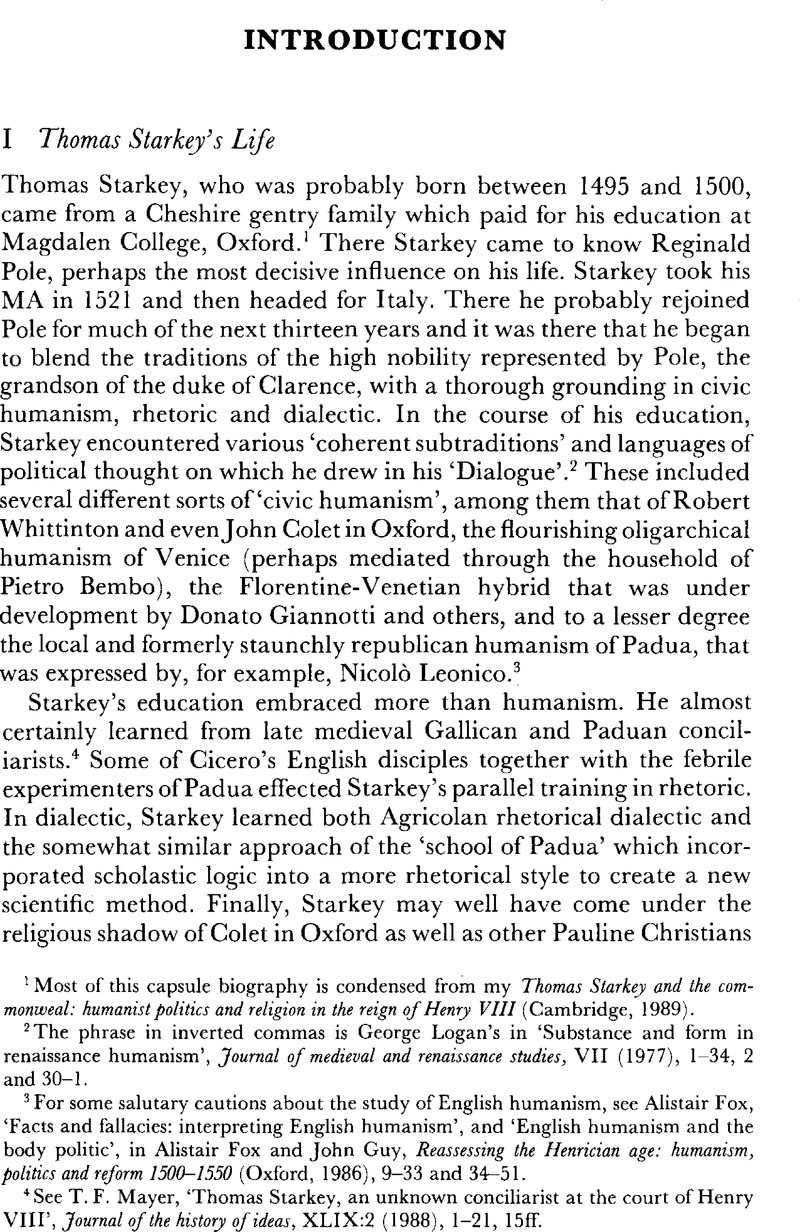No CrossRef data available.
Published online by Cambridge University Press: 21 December 2009

1 Most of this capsule biography is condensed from my Thomas Starkey and the commonweal: humanist politics and religion in the reign of Henry VIII (Cambridge, 1989).Google Scholar
2 The phrase in inverted commas is Logan's, George in ‘Substance and form in renaissance humanism’, Journal of medieval and renaissance studies, VII (1977), 1–34, 2 and 30–1.Google Scholar
3 For some salutary cautions about the study of English humanism, see Fox, Alistair, ‘Facts and fallacies: interpreting English humanism’Google Scholar, and ‘English humanism and the body politic’, in Fox, Alistair and Guy, John, Reassessing the Henrician age: humanism, politics and reform 1500–1550 (Oxford, 1986), 9–33 and 34–51.Google Scholar
4 See Mayer, T. F., ‘Thomas Starkey, an unknown conciliarist at the court of Henry VIII’, Journal of the history of ideas, XLIX:2 (1988), 1–21, 15ff.Google Scholar
5 Mayer, T. F., ‘A mission worse than death: Reginald Pole and the Parisian theologians’, English historical review, CIII (1988), pp. 870–91.CrossRefGoogle Scholar
6 See Mayer, T.F., ‘A diet for Henry VIII: the failure of Reginald Pole's 1537 legation’, Journal of British studies, XXVI (1987), 305–331, 327–30.CrossRefGoogle Scholar
7 For a more thorough treatment, see Mayer, T. F., ‘Faction and ideology: Thomas Starkey's Dialogue’, Historical journal, XXVIII (1985), 1–25CrossRefGoogle Scholar and Thomas Starkey, chapter three.
8 Elton, G. R., ‘Reform by statute: Thomas Starkey's Dialogue and Thomas Cromwell's policy, Proceedings of the British academy, LIV, (1968), 165–88, 167–8.Google Scholar
9 Quentin Skinner outlined the distinction between motive and intention in ‘“Social meaning” and the explanation of social action’, in Philosophy, politics and society, ser. 4, ed. Laslett, P., Runciman, W. G. and Skinner, Q. (Oxford, 1972), 144–47Google Scholar. It seems to me that both should still be taken into account, despite the difficulty that any number of motives may lie behind a single intention.
10 The vulgaria of John Stanbridge and the vulgaria of Robert Whittinton, ed. White, Beatrice, Early English text society, orig. ser., 1932, xxxGoogle Scholar. For the office, see Brewer, J. S. et al. , eds., Letters and papers, foreign and domestic of the reign of Henry VIII (London, 1862–1932), I, no. 232.Google Scholar
11 SP 1/90, fo. 1r (?). The foliation at the beginning of this volume does not come out quite right.
12 Lehmberg, S. E., The reformation parliament 1529–1536 (Cambridge, 1970), 28 and 30Google Scholar, and Bindoff, S. T., ed., The house of commons 1509–1558 (London, 1982), II, 506–7.Google Scholar
13 SP 1/90. fo. 26v. See also, e.g. fo. 20v where Starkey had to replace ‘commune profyte’, a phrase which he regularly used, with ‘commune proverbe’, as one might do if working with only half one's attention; or fo. 57r where Starkey skipped ahead to ‘ryvers’ and then had to go back five words to his proper place.
14 The tags fall between fos. 24 and 25, 25 and 26, 32 and 33, 44 and 45, 58 and 59. From fo. 32 on they are now on the greyer folios, which must once have been more exposed to the air than the rest.
15 Briquet, C. M., Les filigranes. Dictionnaire historique des marques du papier (Paris, 1907).Google Scholar
16 Lanham, R. A., The motives of eloquence: literary rhetoric in the renaissance (New Haven, 1976), 34.Google Scholar
17 See Thomas Starkey, chapter five, and Mayer, T. F., ‘Thomas Starkey's aristocratic reform programme’, History of political thought, VII (1986), 439–461Google Scholar for a more detailed treatment of what follows. For Starkey's relation (or lack of one) to Marsilio, see also Mayer, ‘An unknown conciliarist’, especially pp. 218 ff.
18 See Mayer, , ‘Aristocratic reform programme’Google Scholar for more on Starkey's case. Ives, E. W., ‘Faction at the court of Henry VIII: the fall of Anne Boleyn’, History, LVII (1972), 169–88CrossRefGoogle Scholar offers the best treatment of this faction.
19 Brown, Rawdon, ed., Calendar of state papers and manuscripts, relating to English affairs in the archives and collections of Venice (London, 1873), V, 806.Google Scholar
20 See Mayer, , ‘Reginald Pole's 1537 legation’, pp. 321–7Google Scholar for most of the following.
21 For Sandys, see especially Letters and papers, VIII, 48Google Scholar (Eustace Chapuys-Charles V, 14 January 1535, reporting Sandy's discontent).
22 Moreau, J. P., Rome ou l'Angleterre? Les réactions politiques des catholiques anglais au moment du schisme, 1529–1553 (Paris, 1984), 248.Google Scholar
23 Guy, J.A., ‘The king's council and political participation’, in Fox and Guy, Reassessing the Henrician age, 121–2.Google Scholar
24 Elton, , ‘Thomas Starkey's Dialogue’, 166.Google Scholar
25 Cowper, J. M., England in the reign of Henry the eighth. A dialogue between cardinal Pole and Thomas Lupset, lecturer in rhetoric at Oxford by Thomas Starkey, Early English text society, extra ser., XII (1871), cxxv.Google Scholar
26 Burton, Kathleen M., ed., Thomas Starkey, A dialogue between Reginald Pole and Thomas Lupset (London, 1948).Google Scholar